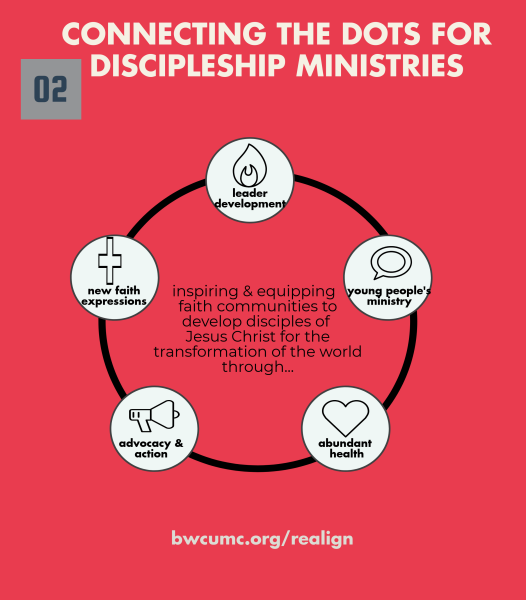Realignment-at-a-Glance
The Baltimore-Washington Conference is in the process of refocusing and realigning its Discipleship Ministries.
This new approach supports our mission of inspiring and equipping faith communities that develop disciples for the transformation of the world. It will streamline connectional missional efforts, awaken potential for partnerships, and shift the focus of hundreds of people from meeting to ministry, from silos to oneness, from operating in fits and starts to moving more rhythmically together. “The changes we are testing and implementing will allow for significant gains in collaboration, relationship
We are organizing our collective work around five purpose-driven: leader development, new faith expressions, young people’s ministry, advocacy & action
In addition to Discipleship Ministries staff realignment, conference agencies and ministries are experimenting with how to collaborate for impact. Each area corresponds to denominational and Annual Conference priorities and creates a clear line of sight between the shared ministries within BWC and the person sitting in the pew. The BWC’s CFA and Nomination Committee
The move toward tables is a response to better connect our collective intentions with tangible impact.
We celebrate the gifts that have been given and a committee structure that once supported the mission well. A review of current conference discipleship committees found nine of the 17 committees in the Discipleship area had not met the previous year or had only convened to create a report for the Conference Journal. Even active committees expressed a need for increased alignment and integration with priorities of the annual conference and many were frustrated with their inability get the word out about what they were doing or to gain traction on the ground. The church is being called into a new place that allows us to join with one another in God’s movement already at work in the world in new ways. We are seeing this at every layer and level of the church.
The realignment is a result of many conversations with stakeholders who value more grassroots focus.
After interviewing agency chairs in July 2017, and sharing findings and ideas with the Nominations Committee, Discipleship Council, and Connectional Table the realignment began to evolve. More refinement has happened in discussions with stakeholders involved in the agencies most impacted by these ideas. “In the course of holy conferencing, the path toward greater collaboration and impact is being built one conversation and relationship at a time,” said Christie Latona, the Director of Connectional Ministries. “I have been amazed at the willingness and enthusiasm of both old-timers and new-comers to actively engage in new ways of being in ministry together.” In summits with the stakeholders within Young People’s Ministry, Advocacy & Action andMission & Wellness we discovered overwhelming support for the realignment. Three to four times as many people prioritized “Collaborative planning and calendaring” and “More people active at the district/local level toward shared goals” as prioritized “Sticking closely with our current structure.”
These tables will operate more like purpose-driven, non-profit boards rather than committees that hold meetings at which reporting is the primary task.
The tables will oversee strategic planning, goal setting and implementation in their given area. A part of this includes identifying and organizing skilled servant workers via working groups and short-term task forces as needed to both expand the number of people connected with each area while also providing more boots on the ground for implementation support and impact. These tables will be given responsibility for allocating, monitoring and reporting on grant funding to meet their areas’ goals and priorities. This will also allow for truly shared leadership between staff and members and greater transparency about how mission shares are being invested each year and toward what end.
Conference leaders are already beginning to see fruit evolving from this new way of being in ministry together.
“This alignment is simultaneously creating common pathways and making us more nimble and intentionally able to respond to the challenges facing the church at this moment in our history,” Bishop Easterling said. In conjunction with finding nine to 12 members to serve on each table, matching grant money will be secured to underwrite some of the tables’ work — including grants for conference ministries and faith communities doing ministry in one of the five areas. A comprehensive grant structure and online application process for providing funding to local churches is being created and will be rolled out this summer. The tables will facilitate the convening and work of many task forces that address specific areas of need and ministry with an eye toward inspiring and equipping local faith communities.
“One of
Realignment and refocusing is a work in progress.
We are not coming to
Refocusing work includes a new nominations process, a new conference leader onboarding process and intentional support to make the shifts necessary.
Realigning is necessary but insufficient to retool leaders and ministry for a new era. A part of this work is about giving
For more information about the realignment, click here (PDF)

